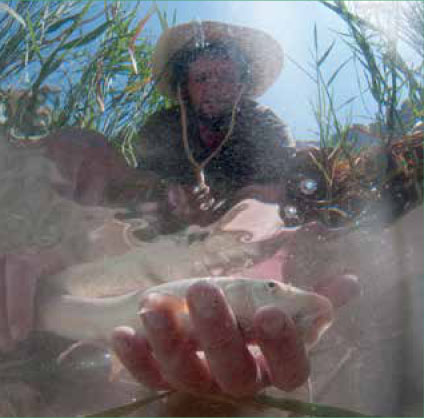9.5 Biodiversity is proving invaluable in the search for cures.
For its part, the mamala tree turned out to be a good save. NCI researchers boiled down the bark and purified the remaining substance, which they named prostratin. Although prostratin had no effect against cancer, as Cox had hoped, it did prove to be a valuable weapon against HIV, the virus that causes AIDS. The first human trials of prostratin began in 2008. Researchers expect the drug to be commercially available in a few years.
So far, mamala bark provides the only known source of prostratin. While small amounts of the compound have been enough to conduct preclinical animal studies, much larger quantities will be needed for large-scale drug manufacturing. Stripping the Samoan rainforest of its mamala trees would be environmentally destructive, not to mention inefficient. So synthetic biologists are looking for better options. By locating the genes responsible for prostratin synthesis and cloning them into a simple organism, like bacteria, they hope to spare the mamala tree from overexploitation. The genetically altered bacteria would then serve as mini prostratin factories—quickly and efficiently producing mass quantities of the molecule which could then be used to make medication. This approach has already been successfully used to scale up production of the plant-derived antimalaria drug artemisinin.
163
Cox is quick to point out that without the Samoans’ help, he would never have found prostratin. The forest he scoured housed two varieties of the tree; only one contained prostratin and within that variety, only trees of a certain size seemed to work (thus emphasizing the value of genetic diversity). The Samoans freely shared this knowledge with Cox. In exchange, he negotiated a profit-sharing agreement with the people of Falealupo. The U.S. government has promised that half of all royalty income from prostratin will go back to them. This represents one of the first formal legal recognitions of indigenous intellectual property rights. In addition to the profit sharing, any commercialized drug developed from prostratin will be supplied to developing countries for free.
While Cox and his colleagues believe ardently in each species’ intrinsic value, they also agree that ethnobotany offers one of the best chances to preserve as many plant species as possible. “There is a strong link between the health of forests and the health of humans,” he says. “If people understand that a rainforest might contain the best cures for diseases that plague us, they will care a whole lot more about saving it.”
Select references in this chapter:
Cox, P.A. 1993. Journal of Ethnopharmacology, 38: 181–188.
Mora, C., et al. 2011. PLoS Biology 9(8): e1001127.doi:10.1371/journal.pbio.1001127.
BRING IT HOME: PERSONAL CHOICES THAT HELP
Species and habitats provide numerous benefits to people, including water and air purification, food sources, recreation, and medicine. Unfortunately, many species are facing threats at ever-increasing levels. The good news is that we as a society have a direct impact on these threats and can make changes to ensure the survival of many of our at-risk species.
Individual Steps
 Don’t buy products made from wild animal parts such as horns, fur, shells, or bones. Only buy captive-bred tropical aquarium fish, not wild-caught fish.
Don’t buy products made from wild animal parts such as horns, fur, shells, or bones. Only buy captive-bred tropical aquarium fish, not wild-caught fish.
 Research the policies of a not-for-profit organization that protects biodiversity, such as the Canadian Wildlife Federation (CWF), the Canadian Parks and Wilderness Society (CPAWS), and the Nature Conservancy of Canada. Is it worth donating money to their cause?
Research the policies of a not-for-profit organization that protects biodiversity, such as the Canadian Wildlife Federation (CWF), the Canadian Parks and Wilderness Society (CPAWS), and the Nature Conservancy of Canada. Is it worth donating money to their cause?
 Make your backyard friendly to wildlife, using suggestions from cwf-fcf.org/en/discover-wildlife/gardening/how-to-garden-for-wildlife/.
Make your backyard friendly to wildlife, using suggestions from cwf-fcf.org/en/discover-wildlife/gardening/how-to-garden-for-wildlife/.
 Install an Audubon Guide app on your smartphone, or buy a field guide to learn the plant and animal species in your area.
Install an Audubon Guide app on your smartphone, or buy a field guide to learn the plant and animal species in your area.
Group Action
 Work with faculty and other students to organize a bioblitz for a protected area in your region. A bioblitz, which is an intensive survey of all the biodiversity in the area, can generate a large amount of data to be used for habitat management and species protection.
Work with faculty and other students to organize a bioblitz for a protected area in your region. A bioblitz, which is an intensive survey of all the biodiversity in the area, can generate a large amount of data to be used for habitat management and species protection.
 Join a citizen science program monitoring wildlife. Many regional conservation groups have monitoring opportunities and provide training. For national programs, visit www.naturewatch.ca, a citizen science monitoring program managed by Nature Canada (www.naturecanada.ca).
Join a citizen science program monitoring wildlife. Many regional conservation groups have monitoring opportunities and provide training. For national programs, visit www.naturewatch.ca, a citizen science monitoring program managed by Nature Canada (www.naturecanada.ca).
Policy Change
 Canada’s Species at Risk Act was established in 2002 to protect species diversity. To learn more, visit the Committee on the Status of Endangered Wildlife in Canada at www.cosewic.gc.ca.
Canada’s Species at Risk Act was established in 2002 to protect species diversity. To learn more, visit the Committee on the Status of Endangered Wildlife in Canada at www.cosewic.gc.ca.

164